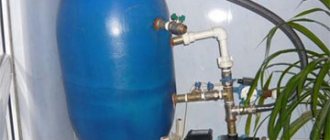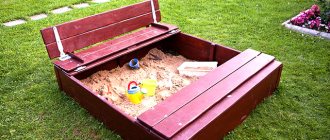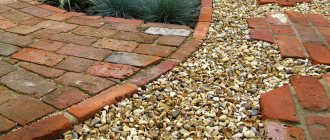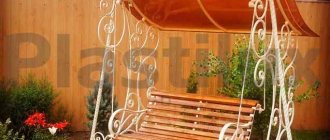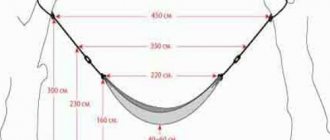Types of pavilions
The structure can be square or round, in the shape of a diamond or half a cylinder. But according to construction characteristics, all structures are classified as stationary or sliding (telescopic).
Pavilion for a polycarbonate pool photo of a stationary structure:
A stationary building is erected on a strip or column foundation. It is not removed for the winter. It is difficult or impossible to modify. There are doors for entry and windows or vents for ventilation. The pavilion can cover not only the water surface itself, but also a recreation area. If you install heating, you can arrange a winter garden and use the building all year round.
A sliding room for a polycarbonate pool is a complex of individual sections that are moved along specially equipped guides. Alternatively, to facilitate movement, rollers are mounted at the bottom. You can move all sections or some of them. Static elements may be absent altogether.
Do-it-yourself pool pavilion made of round polycarbonate: photo
A swimming pool in a summer cottage or garden is a great place for a summer holiday, an opportunity to cool off in the heat, swim and play, and it’s also an excellent design solution. But besides the obvious advantages, owners of stationary pools also face problems: regular cleaning of the water from debris, leaves and insects, the need for artificial heating on cool days, and strong evaporation in the heat. In addition, it is dangerous for families with children to have an open pond.
Swimming pool at the dacha
But pool pavilions will help solve all these problems. These are special structures that completely or partially cover the surface of the water, protecting the pool from litter and evaporation, preventing small children from uncontrolled access to water. And with a large area, pool pavilions can even significantly extend the swimming period, keeping you warm even on cool September days. Advantages of the pavilions:
- The volume of evaporated water is reduced, and it will not need to be added frequently.
- Pool pavilions protect the water surface from debris and leaves, which allows you to save on cleaning and filtration.
- The water retains heat longer, which reduces the cost of heating the pool and extends the swimming season.
- The pavilion covering is a good barrier to ultraviolet solar radiation, which has a detrimental effect on the material of the pool mold.
- Pool pavilions can significantly extend the life of a reservoir. Thanks to the greenhouse effect, the temperature inside the closed structure is much higher than the surrounding one, so the materials of the walls and bottom of the pool are protected from frost.
What types of pool pavilions are there?
Let's look at what types of pool pavilions there are:
By height:
- Low - ideal for rarely used reservoirs. They are inexpensive and compact. Low pavilions have a height of no more than one meter and tightly cover the surface of the water, protecting it from debris and sunlight. To get down to the water with this design, sliding sections are made in the pavilion wall.

Pool pavilion
- Pavilions for swimming pools of average height can reach two meters. As a rule, sliding doors are placed on one side of the structure. In appearance, this type of shelter is similar to greenhouses. The most popular materials for such structures are metal profiles and polycarbonate sheets. In rare exceptions, polyethylene film is used, but in this case the appearance will be lost, and the service life of the film is a couple of years.
- Tall structures. Pavilions for pools over 3 meters high not only perform all the necessary protective functions, but also provide the opportunity to organize a comfortable relaxation area. If the structure is large and there is free space around the pool, then it can be used to place sun loungers, chairs and garden tables, decorating the resulting room with flowers in flowerpots. The greenhouse effect inside the structure will allow you to enjoy swimming even on cool days, and the translucent roof allows you to sunbathe under the sun's rays without the risk of getting burned.
Pavilions can also be divided by type:
- Closed
Closed – protect the pool along the entire perimeter; access to the water is provided by sliding sections or doors.
- Semi-closed
Semi-closed pavilions are a more economical option, covering the surface of the water from only a few sides, mainly from the side of constant winds. This way, debris does not get into the water, but the design cannot perform a full set of protective functions. But it is cheaper to manufacture, and pool owners receive an additional lightweight awning from the sun's rays.
- Sliding
Sliding - sections of the structure are fixed on rails, similar to the fastenings of a sliding wardrobe. Thanks to this, individual parts of the pavilion are moved to the side, opening access to water. By sliding them to one end, you can get a convenient canopy from the sun, and in case of bad weather, quickly cover the water surface from precipitation and debris.
- Temporary
If desired, you can make a collapsible structure and install it only during warm periods. For the winter, after draining the pool, the canopy is unrolled and assembled, waiting for the next warm season in a compact form. Such a mobile pool pavilion is very convenient in small areas, without taking up space during the cold season.

Types of pool pavilions
Depending on the shape of the pool, pavilions are also divided into:
- Round – dome-shaped shelters for round-shaped reservoirs.
- Hemispherical or U-shaped are used for square and rectangular pools.
- Pavilions of complex shapes are built for asymmetrical reservoirs; their production is the most complex and time-consuming.
The pavilions can also be divided according to the material used, they are:
- wooden with film coating;
- glass;
- made of polycarbonate;
- elastic with a frame made of lightweight aluminum.
DIY pool pavilion
Nowadays it’s quite easy to buy a ready-made structure for covering a pond, because the price for a standard and simple cover made from inexpensive available materials is quite reasonable. There are now many manufacturers of such products on the market, production has been put on stream, which has made the purchase of a pavilion accessible to almost everyone.
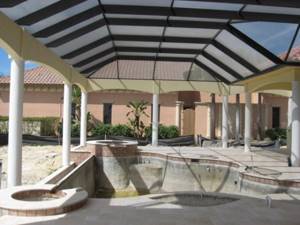
Construction of the pavilion
But owners of asymmetrical reservoirs will have a more difficult time, because conventional covers of standard shapes and sizes will not suit them, and creating an individual project and the work of professionals will cost a pretty penny. It is much cheaper and quite easy to make a pool pavilion with your own hands. This requires time, materials and skills in working with welding and a grinder.
Let's look at the main points of building a pool pavilion:
- Planning and production of drawing
First you need to choose the size of the pavilion, its height, shape and design. This will allow you to create a preliminary drawing and calculate the amount of material required. Most often, pool covers are made of polycarbonate, and the frame is made of a metal profile. After purchasing the required amount of building materials, you can begin making the cover.
When thinking about the construction plan, it is worth designing the entrance to the pavilion in advance. As a rule, this function is performed by sliding sections or doors, and you need to immediately think about their size, placement and method of fastening. Purchasing rails for them should also be included in the shopping list.
- Construction of the foundation
Like any structure, a canopy needs a strong foundation. If the area near the pool is already covered with good tiles, then you can mount the pavilion on it. In another case, it is necessary to create a good half-meter concrete foundation, it must be strengthened with reinforcement with a density of 20 centimeters. When calculating the size of the foundation, you need to take into account that it should protrude beyond the edges of the future canopy by 7-10 centimeters.
- Frame assembly
Next, we install a metal frame on the foundation. It is recommended to use strong pipes or profiles for the main supports; they must be bent into arcs to form a round arched vault. This process should be performed by people who have experience working with metal and a welding machine; this can be either the owner himself or a hired worker. When creating arcs, the profile is cut from the inside using a grinder, bent, and then the cut points are welded and ground.

Pool pavilion plan
The arcs are attached to the foundation using strong bolts at a distance of about a meter. Next, horizontal struts are screwed to them. After assembly is completed, the frame should be treated with an anti-corrosion compound and painted in the desired color.
- Pavilion cladding
After assembling the frame, it is sheathed with polycarbonate. To do this, polycarbonate sheets of the selected thickness and color are marked, highlighting future attachment points to the profile; holes need to be carefully drilled into them a couple of millimeters larger in diameter than the thickness of the screws. These conditions must be met due to the fact that polycarbonate sheets tend to expand when heated.
Next, polycarbonate sheets are alternately attached to the profile, gradually covering the entire structure. The polycarbonate is secured using self-tapping screws, placing galvanized washers between them and the material to seal the holes. The entire plane of the structure is covered with polycarbonate, and sliding doors are also sheathed with it, if they are planned.
Video of building a pavilion for a swimming pool with your own hands
After finishing the work from the inside, the junction of the polycarbonate sheets with the profile must be sealed with sealant. Finally, it is recommended to cover the foundation with tiles or other decorative materials to extend its service life and protect it from moisture, frost and sun. The photo will help you understand the technology of building a canopy. From all of the above, it became clear that building a pavilion for a swimming pool on your own summer cottage is not as difficult as it seems at first glance.
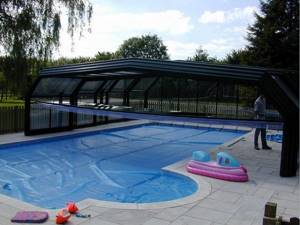
Polycarbonate pavilion
Pool pavilions make it much easier to maintain a pond, and with a large area, they even provide the opportunity to swim in the cool season. At the request of the owner, it can be round, rectangular, square, or even completely non-standard, since modern materials make it possible to quickly and easily produce structures of any height and shape. A well-made pavilion will not only protect the pool from debris, sun and cold, but will also become an unusual decoration for a summer cottage or garden plot.
Author: S. Diana
What to choose: double-glazed windows or polycarbonate
If you are planning a permanent building intended for year-round use, you can purchase double-glazed windows. They can withstand significant frosts and do not let the cold in.
But there is also a significant drawback. To obtain a presentable appearance, double-glazed windows must be ordered from a specialized company. And this is a very large expense. You won’t be able to bend glass yourself or cut it into triangles, rhombuses or squares of ideal shape. In addition, such structures are characterized by significant weight. What is required is not a shallow strip foundation, but a solid monolithic foundation.
Polycarbonate sheets will be a good alternative to glass. They can be cut and bent. It transmits sunlight well. The design is quite light and affordable. You can install a pavilion for a polycarbonate frame pool with your own hands. The most difficult thing in such a situation is assembling the base and arranging the foundation.
We mount the frame
The third stage is the production of a frame from profile pipe supports. Use wide pipes on which you can attach two panels at once with their edges.
Advice. To calculate the required length of support pipes, add up the planned height of the protective pavilion and the width of the pool.
First, bend the prepared supports into arcs:
- use a grinder to make three cuts in the part of the pipe that will bend;
- slowly bend the support to form an arch;
- Weld the previously made cuts and sand them thoroughly.
After this, fix all the arcs one by one on the foundation, forming a frame of the required shape. To ensure reliable fastenings, it is recommended to use double bolts. Maintain a spacing of about 1 m between frame arches.
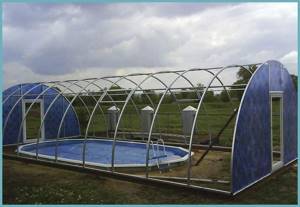
Construction of the frame
As soon as the pipes are fixed, install special horizontal spacers between them - they will take on the function of stiffeners. To make the frame as stable as possible, additionally fix it to the base using steel plates.
Height and shape of the pavilion
Depending on the height, pavilions are classified as low or high. The first ones are often made sliding, designed for situations where swimmers gather from time to time.
The height of the low pavilion does not exceed 1-1.5 meters. The main function of the structure is protection from debris, rain, and snow. A swimming pool under a polycarbonate roof of this height is only available in summer.
Tall buildings are structurally similar to greenhouses. Entrance doors are at the ends. The owner decides whether to make individual sections static or sliding. If dimensions allow, additional chairs and sun loungers are installed inside for relaxation. If you pre-install heated floors and heated water, you can continue training all year round.
Pool pavilion made of polycarbonate photo:
Now it's time to talk about form. In most cases, the structure is made in the form of a horizontally located half-cylinder. The popularity of this option is due to its easy maintenance and construction. Snow does not stay on such a structure, but falls down. Supporting posts and sheets do not burst or become deformed.
In addition, a dome for a polycarbonate frame pool can have the following shape:
- cube or parallelepiped;
- trapezoid;
- domes. Pavilions for round polycarbonate pools are also made in the form of a sphere;
- waves.
In any case, the main thing is to make the structure durable, resistant to wind, snow, and ice. An equally important task is to create a unified style solution with the house, garden (if any), and the rest of the site.
Making a plan
The first stage is the creation of a pavilion project. To do this, you need to decide on the dimensions, type, shape and design of the structure. Based on the height of the building, they are divided into three groups:
- Low – up to 1 in height.
- Medium - from 1 m to 2 m in height.
- Tall - more than 3 m in height.
Advice. If you plan to install tables with sun loungers around the pool, the best solution would be a high pavilion - it will provide the largest space for organizing a comfortable relaxation area.
As for the width, there are two options: either the pavilion fully corresponds to the dimensions of the reservoir bowl, or extends beyond its borders along the perimeter to any distance, depending on your wishes and the area of the site.
By type, pavilions are divided into two groups:
- Semi-closed - protect the reservoir from two or three of the windiest sides.
- Closed - completely enclose the pool on four sides.
The shape of the pavilions can be domed, hemispherical or asymmetrical. Here you should focus on the shape of the specific pool bowl.
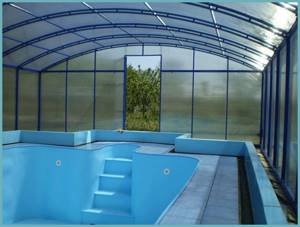
Indoor pool pavilion
Having decided on all the parameters, draw up a plan diagram of the protective pavilion indicating its configuration and dimensions. Do not forget that the closed structure must have a small door or sliding section - indicate it in the drawing.
How to cover a swimming pool with polycarbonate with your own hands
If you have design, construction, and welding skills, you can build a dome for a polycarbonate pool yourself, without contacting specialized companies. In order not to dismantle the ruins after the first winter, it is important to consider several points:
- a foundation is required. It is made wider than the planned pavilion by 5-7 cm on each side. Depth - 50 cm or more. Do not forget that the weight of the structure reaches 5-7 tons;
- the base requires protection from moisture. External surfaces are covered with tiles or porcelain stoneware;
- the edges of the sheets are covered with sealant or special tape. Water should not get inside. Otherwise, it will freeze in winter and tear the cells. The roof over the polycarbonate pool will become unusable.
Construction of the frame
For the main arcs, a large diameter corrugated pipe will be required. The length of each is equal to the sum of the expected height of the pavilion and the width of the artificial reservoir.
It is difficult to obtain arches of the desired height and shape on your own. At this stage, it is better to turn to professionals. If you have experience working with a welding machine, you can work on the arcs yourself. The pipe is cut into pieces of the required length, then the joining process begins. The seams are carefully cleaned and sanded.
To cover a pool with polycarbonate with your own hands, first attach the base of the frame to the foundation, then the arches themselves. For a collapsible pavilion, bolts will be required, for a non-dismountable pavilion, welding will be required. The distance between the arcs is 1 meter. It is necessary to have stiffening ribs, at least 2 for each gap. They not only prevent archwires from moving. Sheets are attached to the ribs to reduce windage. The finished frame is treated with anti-corrosion compounds, primed and painted.
Roof installation
Holes for fastening are pre-drilled in the sheets. The diameter is 0.5-1 mm larger than that of self-tapping screws. Gaps are needed to level out thermal expansion. Another prerequisite is the presence of galvanized washers under the screw heads. If they are not placed, water will penetrate into the honeycombs.
After installing the sheets, all that remains is to seal all the joints with sealant, cover them with decorative strips, and cover the foundation with tiles. The polycarbonate pool roof is ready. You can open the swimming season and save on special chemicals.
Advantages of pool pavilions
- Having built a pavilion, you will be able to stay in it at any time of the year and in any weather, thus making the bathing process round-the-clock and all-season.
- Thanks to this design, you will save money on heating the pool, since the cooling time of the water will be significantly reduced.
- Water evaporation will be greatly reduced.
- The pavilion will always be able to protect small children and prevent them from falling into the water.
- If the canopy is located over the entire bowl, this will maximize the protection of water from debris and dirt getting into it.
- Correct and high-quality design will protect the liquid from the development of algae and phytoplankton in it, that is, it will prevent it from blooming.
- Also, importantly, with such protection you will reduce the amount of necessary chemicals needed to purify water and maintain it in proper condition. As a result, you can save a significant amount of your money.
- Passing through the surface of the canopy, the refracted rays of the sun cause significantly less damage to the materials from which the pool is made, preventing them from burning out, drying out and destruction.
How to care for an indoor pool
We've figured out how to cover a frame pool with polycarbonate with your own hands. All that remains is to find out how to care for it. No special effort is required. The material is resistant to temperature changes, rain, and wind. In winter, snow should be swept away if the layer exceeds 20-30 cm.
Only the metal frame requires special attention. Corrosion stains should not be allowed to appear. If there are swellings, they must be cleaned, then primed and painted.
If the damage is detected late, it is better to replace the arc or stiffener. Otherwise, the entire polycarbonate pavilion may collapse. Construction will have to start again.
The short video below will help you understand what a telescopic structure should look like:

